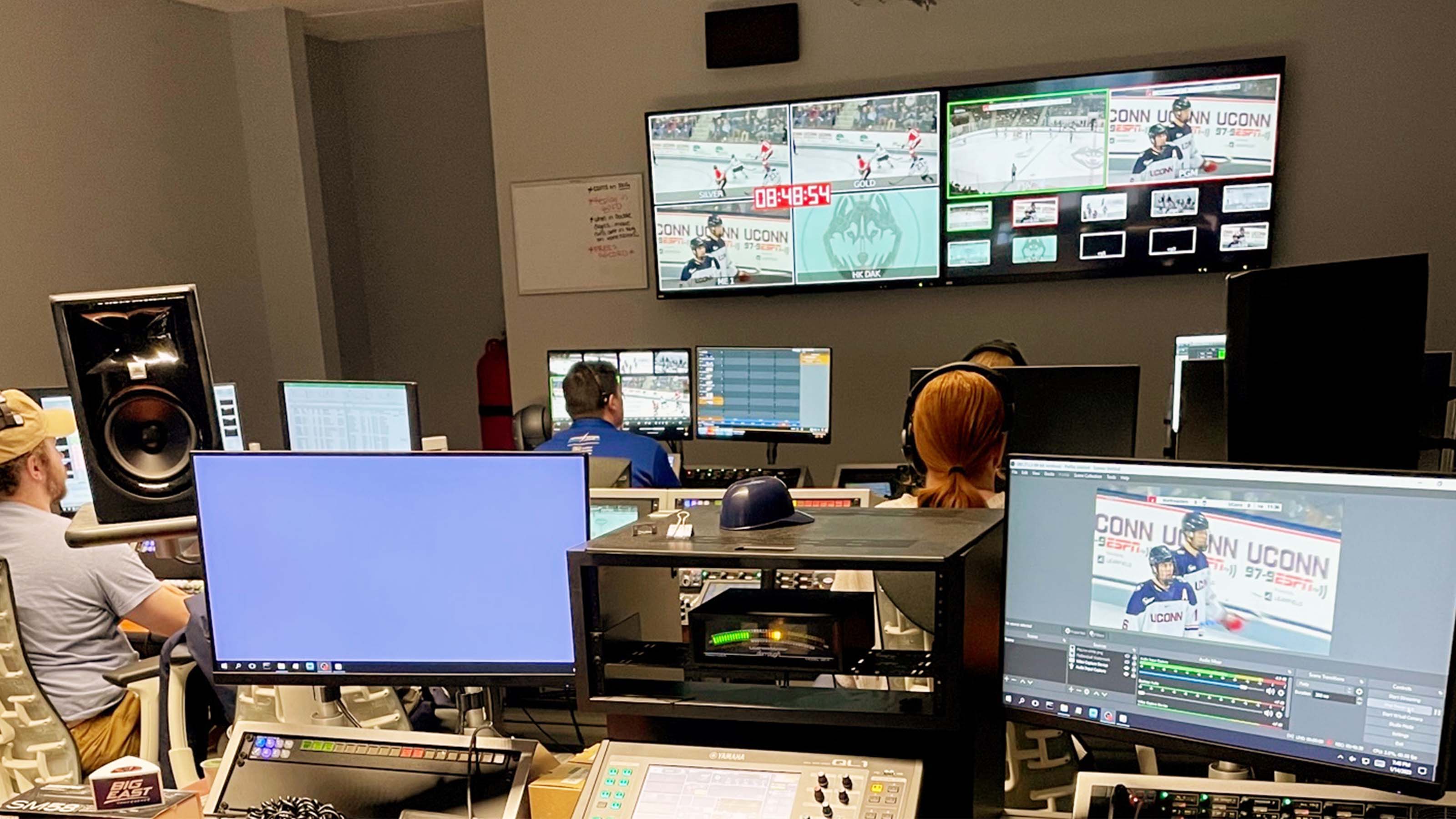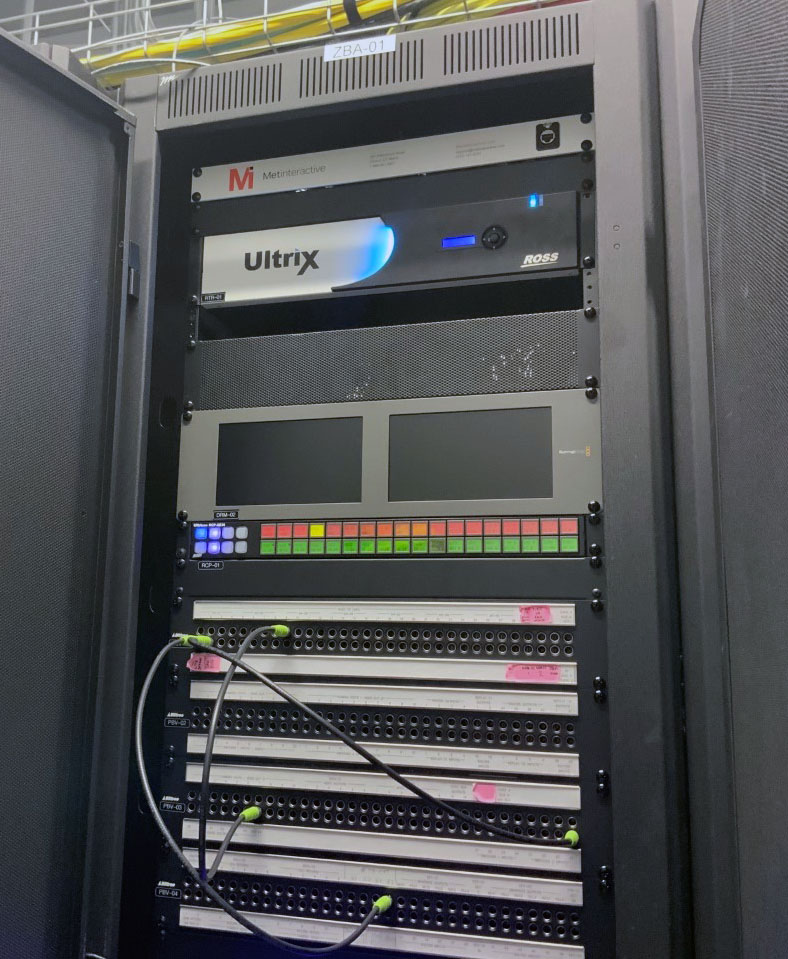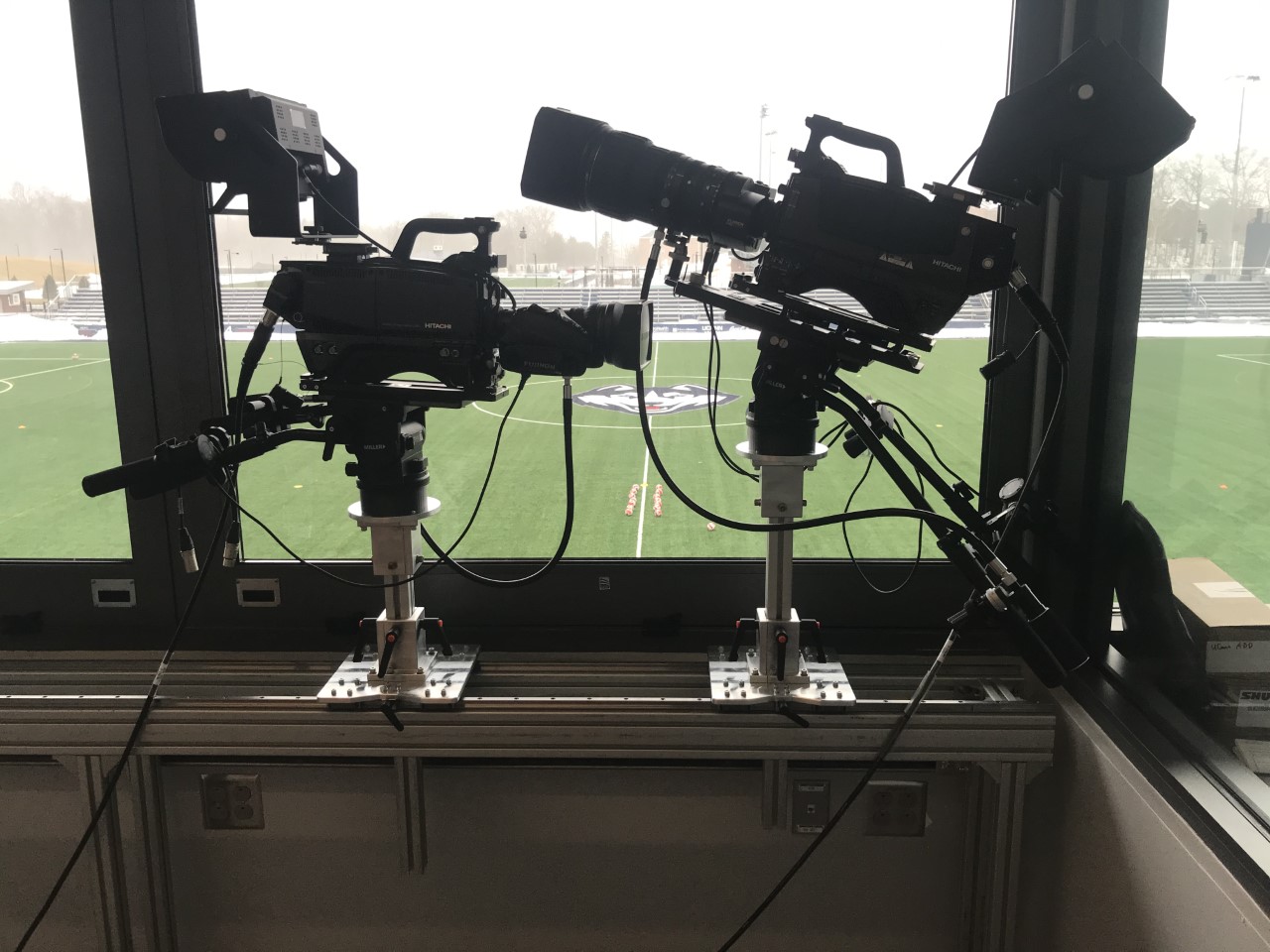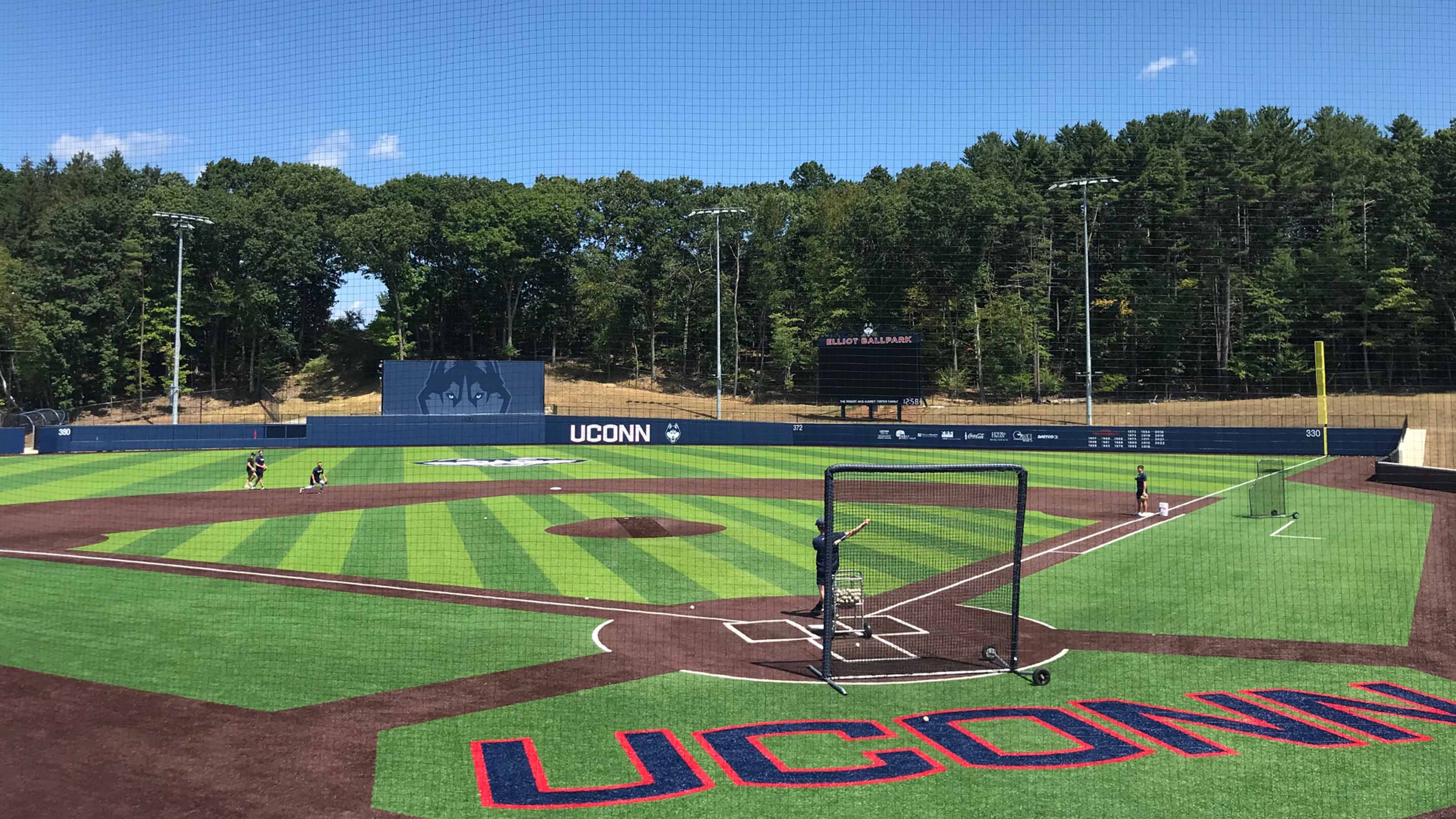
Staying ahead of the game to enhance the fan experience is not simply about the brightest lights and largest scoreboards. In today’s sports world, the latest in-venue broadcast capabilities and audio systems are equally important.
[Major League AV at Toronto's Rogers Centre]
The University of Connecticut is no slouch when it comes to sports. Now, with the help of design and systems integration firm Metinteractive, the Huskies are ahead of the game technologically speaking as well. Metinteractive delivered AV and broadcast integration to the UConn Athletic District Development, a recent program that improved outdated campus sports venues.
UConn in Complete Control
Between the soccer and baseball stadiums is the new Rizza Family Performance Center, which houses the video production control room for on-campus sports. The control room is a blend of Pro AV technology, but the centerpiece items are the Ross Carbonite switchers, Ultrix router, and graphics systems, as well as the Q-SYS system for audio amplifiers and DSP. Also in the production mix are Hitachi SK-HD1200 cameras, Clear-Com intercoms, ElationLogic control and coding solutions (a brand also owned by Metinteractive), and HP Aruba networking.

What is particularly impressive about the control room is that it was designed to produce two live events simultaneously. “The two halves of the room are similar, but not 100% identical," explained Jeff Mele, CTO, Metinteractive. "But there are separate switches, separate replay systems, separate graphics systems, separate scoring systems, all tied with a common network infrastructure and common communication system.”
Of course, a double control room designed to juggle multiple sports didn't come without challenges. “It's an A and B-side double control room, where you have to have the agility to shift which sport is coming out of which side of the room, because there's plenty of overlap," Mele said. "It was always anticipated that softball and soccer would play out of one side and hockey and baseball the other side, because there wouldn't be collisions in some of those. But with the whole COVID era and the cancellations of the season, even up through this year, it's caused mayhem with the schedule for the teams.
"And there are unexpected conflicts in time where you might have to run softball and soccer at the same time. That happened a number of times from a technology standpoint," he continued. "It's a very complex network infrastructure, and a very complex intercom infrastructure, because communications is clearly a key component when your control room is up to half a mile away from some of your venues.”
“From a network standpoint, I highly suggest that projects don't go the way of trying to converge networks with the rest of the facility—not because of a technological reason, but because of an aptitude reason.”
Jeff Mele, Metinteractive
The decision was made to connect the multiple venues via fiber. According to Mele, there was no other option. “In current sports applications, I still see mistakes happen where consultants will specify coaxial cable just for the in-house cabling, let alone going building to building," he explained. "Part of the problem with that is your distance limitation is pretty fierce. So, the strategy inside the buildings these days is all about running fiber. As an example, the hockey arena—bringing that online, we ran 72 strands of single mode back to the control room."
One System for All
As with most college athletics operations, there is a slew of different hands in the control room for broadcast production, including students with a range of experience levels. Metinteractive knew they needed to design a system that could be easily controlled by a wide variety of end users.
“We use a diverse group of people—students, full-time staff, and even freelancers at times,” explained David Kaplan, assistant athletics director of video and production services at UConn. “The system is extremely user friendly for all the different people we bring in.”

“David Kaplan is an amazing producer, and they've got a great assembly of cohesive people that worked on making UConn's games a great experience,” said Mele. “But there are those moments where things happen, and they need assistance. And if we had to, we could fundamentally run the whole game remotely. Most of us [at Metinteractive] have come out of live production, so we understand the gig of having to be able to turn stuff on and hope to God it's all going to work. And that makes us very well adapted for dealing with clients like this, because they need somebody who's not going say, ‘Oh, we'll have to send you a quote for that,’ or ‘We'll have somebody get back to you within two hours.’”
[Future Proof Control Room Connectivity]
You may be familiar with another iconic sports name that resides close by in Connecticut. When ESPN wants to air a game from the UConn, there is no reason for anyone to come on site. The system is designed to push streaming content to ESPN, which is another example of how easy this complex system makes things on the athletics department.
Thus far, the system has been a success. Mele, who has led Metinteractive's recent string of successful installations for Major League Baseball, offered advice for the future of gameday integrations. "Most of our projects this past year, we have been in control of our own destiny," Mele offered. "From a network standpoint, I highly suggest that projects don't go the way of trying to converge networks with the rest of the facility—not because of a technological reason, but because of an aptitude reason. What goes into what we do from a networking perspective is far more complicated than what the average IT person is dealing with on a day-to-day basis. IT folks are dealing primarily with intercommunication and security, whereas we're dealing with multicast traffic, precision time concepts that don't really mean much to the typical, day-to-day IT person."

While Daktronics took care of the videoboards, Metinteractive amped up the acoustics on the field. According to Kaplan, the sound is "absolutely fantastic" and has exceeded expectations. An EAW outdoor speaker system pumps up the fans, but there were also some fun technologies, like systems to analyze baseball and softball players' swings, that enhance the team experience as well. Metinteractive has also equipped the new Toscano Family Ice Forum for the men’s and women’s hockey team with a d&b PA system, among other technological solutions.
[How Samsung Is Bringing the Pro AV 'Wow' to Citi Field]
“For us, within the last two years, we’ve put up new soccer, baseball, softball, lacrosse, and now hockey venues,” said Kaplan. “Metinteractive has been involved in all of those from an audiovisual standpoint. Due to their work, we’ve had some great shows and are looking forward to build in the new arenas.”
Hometown Home Run
All parties involved are happy with the installation, but even more so with the relationship built between the school and integrator. Especially for Mele, whose family grew up a fan of the Huskies, this project was a little bit more rewarding.
"We certainly believe in all of our clients, but there will be something to be said for the hometown advantage here," said Mele. "There's a little extra tilt on this when you're dealing with your own home team—and especially being a state institution. But it's all a matter of just making sure you want all your clients to have a great experience."
[Editorial: Take Me Out to the Scoreboard]
“During the design phase and installation, Jeff and his group were always available to us, helped guide us along when needed,” Kaplan explained. “Now that we are producing shows in the venues, they are always available and coming on site when needed. It’s been a great partnership. Sometimes installations come and the companies go. And I don’t think it’s just because they are a Connecticut company; they are willing to be there well after the installation and help in any way they can.
“I’ve talked to other people in Major League Baseball and hockey arenas around the country. We didn’t just hire them because they are Connecticut-based. We hired them for their expertise and the value they bring after the installation.”







